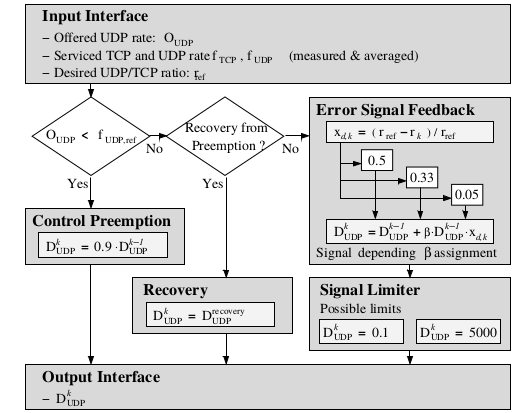
Links
Abstract
Today’s known and widely used active queue management (AQM) schemes do not differentiate between packets from responsive (e.g., TCP sessions) and non-responsive traffic (e.g., UDP). This results in further widening the gap of unfair advantage already inherent to non-responsive traffic, as the responsive sender will significantly reduce its future transmit rate as a result of the congestion signals. As a simple work-around, responsive and non-responsive traffic are often assigned distinct AQM parameters. This approach however requires tuning for each traffic class that potentially depends on the current or expected offered load. In other words, responsiveness and TCP-friendliness cannot be estimated easily—not at last due to short-lived TCP sessions. In this paper we propose a closed-loop congestion control (CLCC) scheme on top of an existing AQM scheme to achieve fair bandwidth distribution among concurrent responsive and non-responsive traffic. The new scheme has the advantage that it does not need to estimate the level of responsiveness of traffic. We analyze our scheme on top of an existing rate-based AQM scheme known to approximate max-min fairness, and by means of simulations show that our extension significantly improves fair bandwidth allocation for responsive and non-responsive traffic. The simulation results have been verified with a prototype implementation on the IBM PowerNP 4GS3 network processor.
Note
Our paper on PURPLE also uses control engineering for AQM. PURPLE’s goal is to provide for low jitter, delay, and packet losses while maintaining high throughput and goodput.
BibTeX (Download)
@inproceedings{Pletka2003Closed-Loop,
title = {Closed-Loop Congestion Control for Mixed Responsive and Non-Responsive Traffic},
author = {Roman Pletka and Andreas Kind and Marcel Waldvogel and Soenke Mannal},
url = {https://netfuture.ch/wp-content/uploads/2003/pletka03closedloop.pdf},
year = {2003},
date = {2003-01-01},
urldate = {1000-01-01},
booktitle = {Proceedings of Globecom 2003},
abstract = {Today's known and widely used active queue management (AQM) schemes do not differentiate between packets from responsive (e.g., TCP sessions) and non-responsive traffic (e.g., UDP). This results in further widening the gap of unfair advantage already inherent to non-responsive traffic, as the responsive sender will significantly reduce its future transmit rate as a result of the congestion signals. As a simple work-around, responsive and non-responsive traffic are often assigned distinct AQM parameters. This approach however requires tuning for each traffic class that potentially depends on the current or expected offered load. In other words, responsiveness and TCP-friendliness cannot be estimated easily—not at last due to short-lived TCP sessions. In this paper we propose a closed-loop congestion control (CLCC) scheme on top of an existing AQM scheme to achieve fair bandwidth distribution among concurrent responsive and non-responsive traffic. The new scheme has the advantage that it does not need to estimate the level of responsiveness of traffic. We analyze our scheme on top of an existing rate-based AQM scheme known to approximate max-min fairness, and by means of simulations show that our extension significantly improves fair bandwidth allocation for responsive and non-responsive traffic. The simulation results have been verified with a prototype implementation on the IBM PowerNP 4GS3 network processor.},
keywords = {Control Engineering, Fast Routers, Traffic Engineering},
pubstate = {published},
tppubtype = {inproceedings}
}



